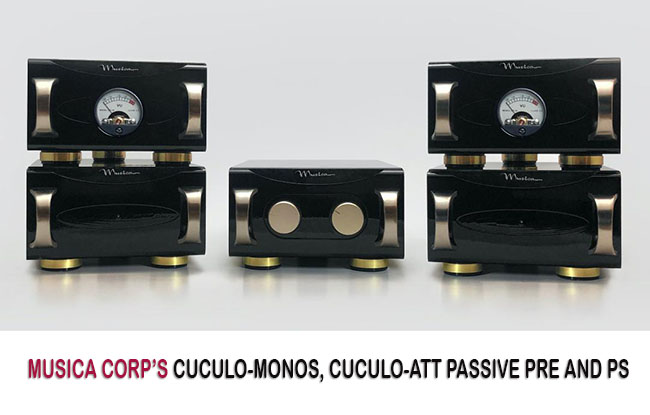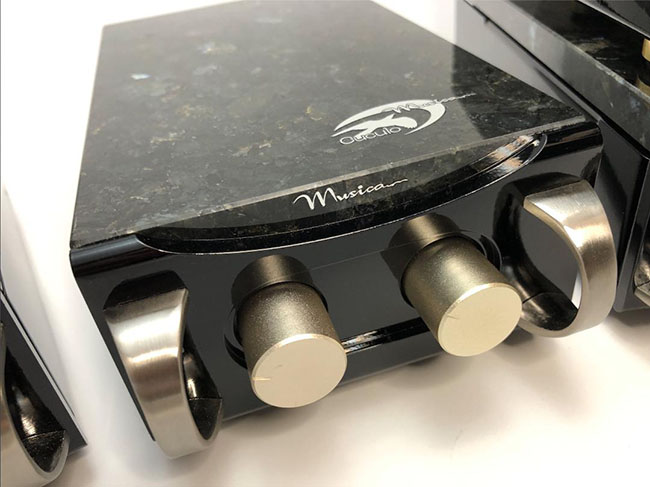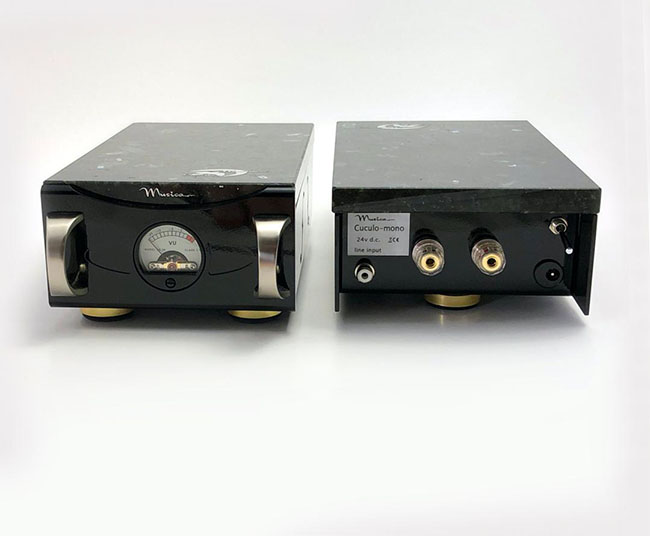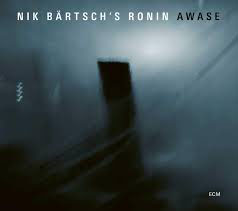MUSICA CORPORATION Cuculo-monos, Cuculo passive pre and PS by Greg Voth

 Kahl Audio, located in Northvale, NJ, the US distributor for the MUSICA Corporation’s Cuculo brand, recently contacted me with components for review. Once I received delivery and had the Cuculo components connected and playing with an older source, I fired up the iMac. I set out to uncover information about MUSICA and the brands under its umbrella. Established in 2005, the MUSICA Corporation is a hi-fi brand from Japan that develops high-quality audio equipment (i.e., power amplifier, PC audio system, analog disk player, etc.) for commercial sale. MUSICA established a professional audio system section in 2007 and, perhaps with diversity a goal, MUSICA offers a wide range of audio equipment for sale, besides their own branded lines, from components and loudspeakers, turntables and cartridges, racks and isolation feet, speaker leads, and interconnect cables. The brands I see in the catalog pages included are Rega, Grado, Quadral, Celestion, and Sound Magic.
Kahl Audio, located in Northvale, NJ, the US distributor for the MUSICA Corporation’s Cuculo brand, recently contacted me with components for review. Once I received delivery and had the Cuculo components connected and playing with an older source, I fired up the iMac. I set out to uncover information about MUSICA and the brands under its umbrella. Established in 2005, the MUSICA Corporation is a hi-fi brand from Japan that develops high-quality audio equipment (i.e., power amplifier, PC audio system, analog disk player, etc.) for commercial sale. MUSICA established a professional audio system section in 2007 and, perhaps with diversity a goal, MUSICA offers a wide range of audio equipment for sale, besides their own branded lines, from components and loudspeakers, turntables and cartridges, racks and isolation feet, speaker leads, and interconnect cables. The brands I see in the catalog pages included are Rega, Grado, Quadral, Celestion, and Sound Magic.
 MUSICA’s commitment to audio is deep beyond the few components that I have on hand… the offerings found on their website indicate what appear to be four different component designations, from the most feature-rich Raicho4 and Cuculo series, the Crane series, and Ibuki4 components. All MUSICA components are made in Japan. A few catalog sheets came with MUSICA’s Cuculo components for review – predominantly written in Japanese; they reveal the company’s commitment to audio lovers, with photos of various components. Accompanied by only sprinkles of English, identifying the actual use for many of the components in the Cuculo line would take a little detective work. The MUSICA website is not the best of places for an English-only speaker. While their product drop-down listed the four series mentioned above, only four components were listed in the Cuculo series (all amplifiers). Silly me, I expected hyperlinks to each product listed on the catalog sheets. Thankfully, I thought of a work-a-round – I clicked on the link for the Cuculo-mono amp and, one at a time, subbed in model designations for each of the known Cuculo components. Each attempt led me to their online pages, where I discovered a few paragraphs in Japanese for each. I then copied and pasted select paragraphs into a web-based translation function. A bit time-consuming but rewarding, as some of my initial assumptions about the components, based on each model’s nomenclature, proved incorrect. Paraphrasing the text readable on the MUSICA site, their Cuculo series derives its name from the cuckoo played by a clarinet of Beethoven’s Symphony No.6. The Cuculo series is comprised of separates, and each component has a width of 119mm. For a Cuculo series, there are no screws visible on a front, surface, or side. The body of the Cuculo is made at a tank factory in the Tokai area, a historic area of Japan. The PC board of the Cuculo is made in the same factory as that of Lexus and Toyota’s automobiles. Each panel’s top covert is adorned with a natural stone slab called “Emerald Pearl,” found in Norway and processed in the Tokai area.
MUSICA’s commitment to audio is deep beyond the few components that I have on hand… the offerings found on their website indicate what appear to be four different component designations, from the most feature-rich Raicho4 and Cuculo series, the Crane series, and Ibuki4 components. All MUSICA components are made in Japan. A few catalog sheets came with MUSICA’s Cuculo components for review – predominantly written in Japanese; they reveal the company’s commitment to audio lovers, with photos of various components. Accompanied by only sprinkles of English, identifying the actual use for many of the components in the Cuculo line would take a little detective work. The MUSICA website is not the best of places for an English-only speaker. While their product drop-down listed the four series mentioned above, only four components were listed in the Cuculo series (all amplifiers). Silly me, I expected hyperlinks to each product listed on the catalog sheets. Thankfully, I thought of a work-a-round – I clicked on the link for the Cuculo-mono amp and, one at a time, subbed in model designations for each of the known Cuculo components. Each attempt led me to their online pages, where I discovered a few paragraphs in Japanese for each. I then copied and pasted select paragraphs into a web-based translation function. A bit time-consuming but rewarding, as some of my initial assumptions about the components, based on each model’s nomenclature, proved incorrect. Paraphrasing the text readable on the MUSICA site, their Cuculo series derives its name from the cuckoo played by a clarinet of Beethoven’s Symphony No.6. The Cuculo series is comprised of separates, and each component has a width of 119mm. For a Cuculo series, there are no screws visible on a front, surface, or side. The body of the Cuculo is made at a tank factory in the Tokai area, a historic area of Japan. The PC board of the Cuculo is made in the same factory as that of Lexus and Toyota’s automobiles. Each panel’s top covert is adorned with a natural stone slab called “Emerald Pearl,” found in Norway and processed in the Tokai area.



In For Review
I’ll be reviewing the Cuculo models on hand, the Cuculo-mono, Cuculo-PS, and the Cuculo-passive-attenuator (herein att). The Cuculo-mono is a pure analog 50W amplifier (a universal power supply comes standard). One might choose to power a mono amp by the Cuculo-PS, a dedicated power supply that can be used with other components in the Cuculo and other MUSICA lines where 24 DC is required. Lastly, the Cujculo-att is a passive attenuator [line preamplifier]. Each Cuculo component in the line has front-mounted brushed metal handles. My measurements show these three units to be approximately W118mm H71mm D216mm (including front handles), which translates to about 4.64″ W x 2.79″ H x 8.5″ D each. Each component measures a 119mm width in this series, and each is finished in gloss black (I don’t see other colors available) with brushed metal knobs and chrome switches where needed (the att is passive, with no power going to the unit). All three components have the stone top layer mentioned above, three metal feet (28mm in diameter), with each foot affixed with a soft cushion bottom layer. The Cuculo-mono power amplifiers have an illuminated front-mounted circular meter and “ƒ” hole shapes cut into their steel chassis sides. MUSICA describes these as “air holes for heat dissipation on the side [that] imitate the F hole of the violin.” A few other products in the Cuculo have ‘ƒ’ hole vents visible as well.



Setup
 I had the three Cuculo components, a digital source plugged into a Core Power Technology EQUI=CORE 300, and the Cuculo-mono’s and Cuculo-ps dedicated power supplies stacked. Two mono amps are required for stereo output, and two ps units are necessary if the setup’s dedicated power supplies are desired. At start-up, as each amp and ps turned on with a low soft thump, I detected a slight hiss from the center of the DI’s tweeter array that could be heard (lightly) from the sweet spot. After some troubleshooting, I found the source of the hiss to be an older source that I brought up to use earlier in the month. Once I switched to my laptop and an external DAC, the hiss was no more.
I had the three Cuculo components, a digital source plugged into a Core Power Technology EQUI=CORE 300, and the Cuculo-mono’s and Cuculo-ps dedicated power supplies stacked. Two mono amps are required for stereo output, and two ps units are necessary if the setup’s dedicated power supplies are desired. At start-up, as each amp and ps turned on with a low soft thump, I detected a slight hiss from the center of the DI’s tweeter array that could be heard (lightly) from the sweet spot. After some troubleshooting, I found the source of the hiss to be an older source that I brought up to use earlier in the month. Once I switched to my laptop and an external DAC, the hiss was no more.
Listening
Though small in stature, these five Cuculo components produced ample lower frequencies and displayed an innate ability to handle dynamic content, with five clicks of rotation of the 23-contact rotary switch for adjusting the volume on the alt’s front face. The two 50 watts Cuculo-mono amps paired very nicely with my 98.82db sensitive 4 Ohm Tekton Design Double Impacts. The Cuculo components delivered a warm commanding tone with surprising musicality. As a test, I paired the Cuculo units with my Channel Island Audio r3 monitors, stunning 8 Ohm loudspeakers with a sensitivity of 86dB @ 1 watt; I clicked up roughly the same amount to match the volume in memory from the DI’s, which surprised me. With song levels being different, your mileage may vary. With a play by Aaron Goldberg’s Worlds (2006 Sunnyside Communications), the Cuculo units delivered musical heft far outweighed their size, with density and nice body in every note played. On song after song, low frequencies flowed unhampered, with punch and power, and acoustic instruments glowed with authority. The soundstage was nicely defined and imaging sharp –and the sound was warm, inviting, and not at all analytical. Transients were quick, and there was a nice swing in dynamics.
 Moody and languishing, “Modul 60,” the first track on Nik Bartsch’s Ronin 2018 Awase release (ECM Records GMBH), depth, air, and density were applied through the Cuculo units, with crisp transients flowing in a warm, low-frequency breeze. The second track, “Modul 58,” opened slowly as the first, before percussion brought energy to the forefront. Bass entered with a wallop onto a quite refined stage, with instruments sharply imaged as the stage drew further to the rear, and rhythmic input provoked the space around the players. The repetitive phrases and rhythms are magical, with subtle shifts and changes. Quiet gave way, yet unhurried, as dynamics punctuated with bleeps and blurts from a bass clarinet were injected as a bit of humanity into this methodically intricate overlay of rhythms. The piano image was stable and well-grounded, the bass solid and driving and the percussion crisp, with great body and nuance.
Moody and languishing, “Modul 60,” the first track on Nik Bartsch’s Ronin 2018 Awase release (ECM Records GMBH), depth, air, and density were applied through the Cuculo units, with crisp transients flowing in a warm, low-frequency breeze. The second track, “Modul 58,” opened slowly as the first, before percussion brought energy to the forefront. Bass entered with a wallop onto a quite refined stage, with instruments sharply imaged as the stage drew further to the rear, and rhythmic input provoked the space around the players. The repetitive phrases and rhythms are magical, with subtle shifts and changes. Quiet gave way, yet unhurried, as dynamics punctuated with bleeps and blurts from a bass clarinet were injected as a bit of humanity into this methodically intricate overlay of rhythms. The piano image was stable and well-grounded, the bass solid and driving and the percussion crisp, with great body and nuance.
 Kandace Springs’ cover of “Soul Eyes,” from her album of the same title (2016 Blue Note Records), has been a track played often. Simply captivating. Its air of heat and passion was well rendered through the diminutive Cuculo rig. These small-ish components presented her silky voice beautifully – smokey, warm, and tinged with honey. This track is short but impactful, as the rhythm section, augmented with guitar and trumpet, lays back, polishing the edge of every languishing note. “No Return,” from Chrissie Hynde’s Valve Bone Woe (2019 BMG Rights Management), is a big song that sounds like the main theme from a James Bond movie. It opens, complete with sound effects that set the mood, on a stage both wide and deep, with its big studio sound reaching generously wide and to stage rear. Hynde’s vocal was full, sexy, and closely miked – pop at its best and schmaltzy in all the right places. The mood and breadth of this cinematic work were captured nicely by the Cuculo monos, PS, and att combo.
Kandace Springs’ cover of “Soul Eyes,” from her album of the same title (2016 Blue Note Records), has been a track played often. Simply captivating. Its air of heat and passion was well rendered through the diminutive Cuculo rig. These small-ish components presented her silky voice beautifully – smokey, warm, and tinged with honey. This track is short but impactful, as the rhythm section, augmented with guitar and trumpet, lays back, polishing the edge of every languishing note. “No Return,” from Chrissie Hynde’s Valve Bone Woe (2019 BMG Rights Management), is a big song that sounds like the main theme from a James Bond movie. It opens, complete with sound effects that set the mood, on a stage both wide and deep, with its big studio sound reaching generously wide and to stage rear. Hynde’s vocal was full, sexy, and closely miked – pop at its best and schmaltzy in all the right places. The mood and breadth of this cinematic work were captured nicely by the Cuculo monos, PS, and att combo.
 Jacob Collier’s Djesse Vol. 2 (2019 Hajanga; Decca / Geffen) always pleases me – it’s uplifting, joyful, and, frankly, my favorite of his 3 Djesse volumes. The Cuculo trio dug into this music, delivering music with a body, passion, and punch. “Sky Above” came in with a wallop, with bass thick but not bloated, and a listen of “Bakumbe” was pure hoe-down fun. “Tell Me Why” was warm, held together with honey and heart. Bass wafted through as the delicacy of the acoustic instruments ebbed and flowed around these wonderful vocals arrangements.
Jacob Collier’s Djesse Vol. 2 (2019 Hajanga; Decca / Geffen) always pleases me – it’s uplifting, joyful, and, frankly, my favorite of his 3 Djesse volumes. The Cuculo trio dug into this music, delivering music with a body, passion, and punch. “Sky Above” came in with a wallop, with bass thick but not bloated, and a listen of “Bakumbe” was pure hoe-down fun. “Tell Me Why” was warm, held together with honey and heart. Bass wafted through as the delicacy of the acoustic instruments ebbed and flowed around these wonderful vocals arrangements.
The Wrap
There’s nothing shy about the Musica Cuculo components; the music was very well presented, delivering good body and heft. This trio comes out to play with compelling depth and an excellent thickening to images on the stage. Dynamics are notably present with speed and impact, and transients breathed with authority offering nice leading edges while leaving no metallic after taste. I do hope you’ll give them an audition!


greg voth
Specifications:
Model name : Cuculo-att
Price: $795
• Type: passive line preamplifier
• Output power: 1000mw
• Inputs: 4xRCA unbalanced inputs (in stereo pairs)
• Outputs: 1 pr x RCA input
• Dimensions: W119mm x H70mm x D196mm (chassis only)
• Input impedance: 50KΩ
• Level adjustment: 0 to -∞ dB (23 steps)
Model name: Cuculo-mono
Price: $795 ea
• Type: Monaural power amplifier
• Output power: 50w
• Output impedance: More than 4 ohms
• Frequency Response: 5Hz-80KHz
• Inputs: 1xRCA input
• Dimensions: W119mm x H70mm x D196mm (chassis only)
• Power Requirements: 100-240v ac
• Plug types: type A(USA,Japan)
Model name: Cuculo-ps
Price: $795
• Can be used for models with a power supply voltage of 24v d.c.
• Cuculo-ps is ultra-low noise and the output is stable.
• 10 times more capacitance than the included power supply.
Made by: MUSICA CORPORATION
1996 Ichinose Kamiisizu-cho
Ogaki-city Gifu, Japan
US distributor:
Ken Kahl
Kahl Audio
148 Veterans Dr Suite D
Northvale, NJ 07647
(201) 564-7055
– – –
Stereo Times Masthead
Publisher/Founder
Clement Perry
Editor
Dave Thomas
Senior Editors
Frank Alles, Mike Girardi, Russell Lichter, Terry London, Moreno Mitchell, Paul Szabady, Bill Wells, Mike Wright, and Stephen Yan,
Current Contributors
David Abramson, Tim Barrall, Dave Allison, Ron Cook, Lewis Dardick, John Hoffman, Dan Secula, Don Shaulis, Greg Simmons, Eric Teh, Greg Voth, Richard Willie, Ed Van Winkle, Rob Dockery, Richard Doron, and Daveed Turek
Site Management Clement Perry
Ad Designer: Martin Perry







Be the first to comment on: MUSICA CORPORATION Cuculo-monos, Cuculo passive pre and PS by Greg Voth